Images are one of the most useful tools for online stores to connect with customers. Quality images of your product will increase your conversion rate and increase your search ranking. Using high quality apparel images on Amazon is definitely a must when selling clothes.
In this article, you’ll learn how to comply with Amazon’s guidelines and we’ll give you some tips on how to make your products stand out.
Types of Apparel Images on Amazon
There are different types of Apparel Images you can use on Amazon:
Main Image
It’s mandatory for all products, not only apparel to have a main image showing since it will appear when a customer is browsing for something. It also that appears within the product detail page, and when customers click on it, a pop-up window shows them the full-size view.

Alternate images
These images are there to help sellers show their customers details of the product, such as: fabric, details and use, or just different views. They also portray the best features of a product that a shopper is already interested in buying. Amazon allows you to use up to seven alternate images for each ASIN.
Swatch images
These are 30×30 pixel thumbnails that appear next to the name of the color, and they are used to show the product in the different colors or fabrics available.
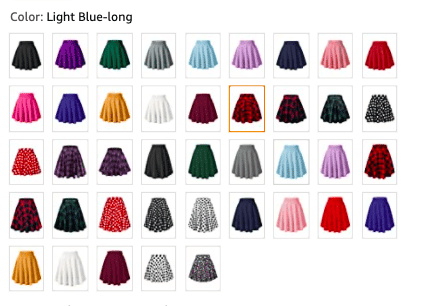
Where Will My Images Appear?
Apparel Images will be shown across pages of Amazon:
- Search Page: The Main image appears in the search results.
- Browse Page: The Main image appears on pages of specific categories and browse widgets.
- Detail Page: Here’s where customers can take a look at full product details and images.
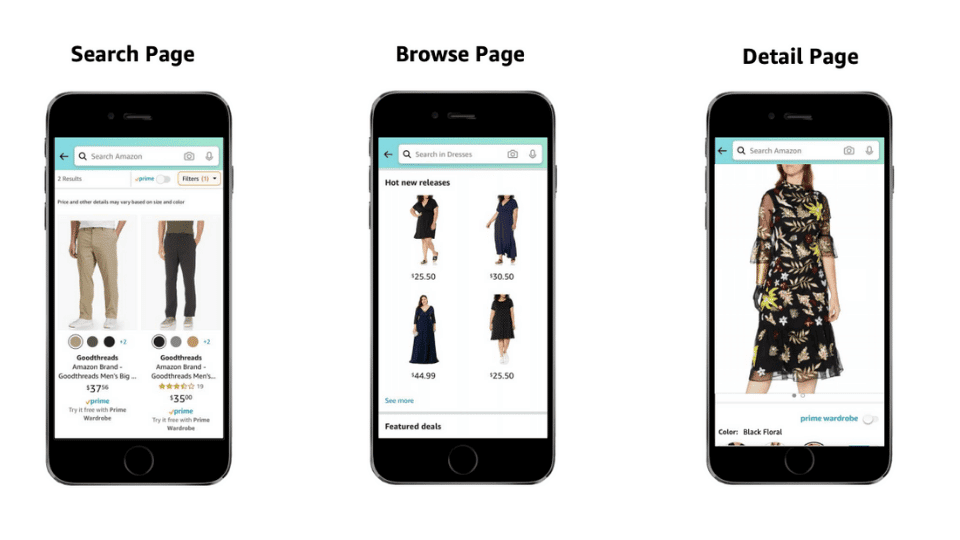
Source: SELLER IMAGING GUIDE: Clothing & Accessories Spring 2021 | PAGE 6
About Parent and Child ASINs
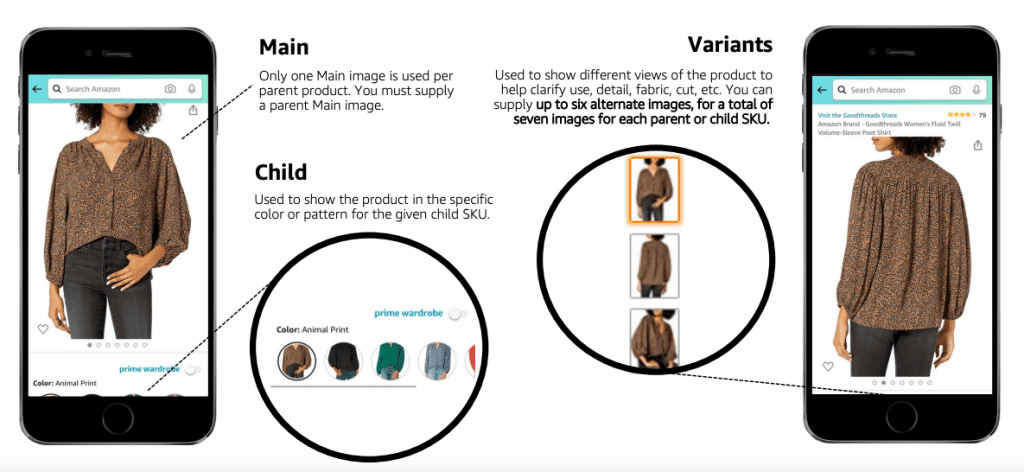
Source: SELLER IMAGING GUIDE: Clothing & Accessories Spring 2021 | PAGE 8
In Apparel, a Parent product is the one with a specific color variation. The set of images of this product will be the one that will showcase first in your listing. When there is a variation of a pattern or color or any other kind, then that is the Child product.
All parent and child products are required to have a single Main image to display on the Search and Browse pages.
Sellers can decide to add alternate images, depending on how much detail they want to highlight. Amazon allows you to include different images per product, so take advantage of that to help clients connect with your brand.

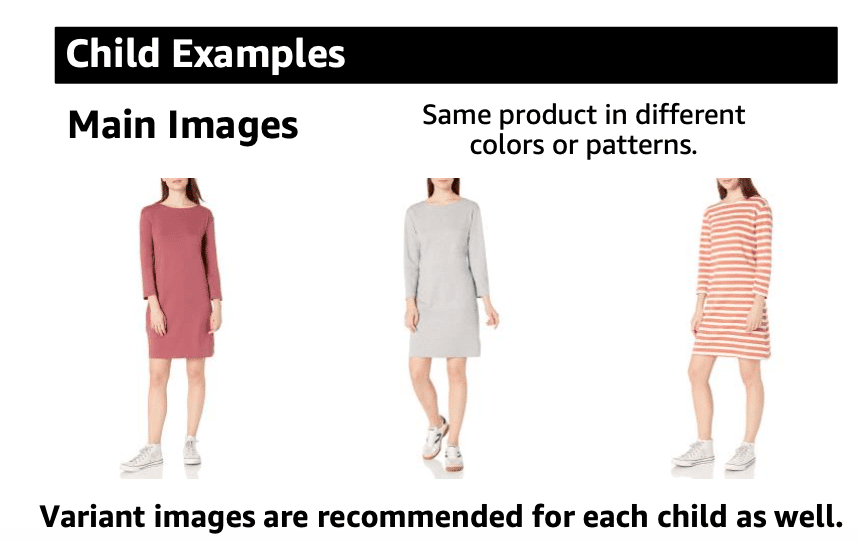
Images source: SELLER IMAGING GUIDE: Clothing & Accessories Spring 2021 | PAGE 9
Technical Requirements for Apparel Images
Amazon has a couple of guidelines to make sure you’re not uploading low-quality images that will harm your sales instead of increasing them. You need high-resolution images (for both main and alternate images):
- On the long side, images must have a minimum size of 500px and a maximum size of 10,000px.
- Zooming starts at 1000px on the longest side and 500px on the shortest.
- You can upload images in JPEG (.jpg) or GIF (.gif) formats, but JPEG is preferred.
- You should use sRGB colors
- Images have a maximum size of 10 MB
- You can use a ratio or crop up to 5:1 rectangle, although the best may be a 1:1 square image.
Amazon’s Recommended Settings
- The maximum zoom option is 2000px by 2000px.
- The product is the star of the image, so crop your image in such a way you take advantage of most of the space in the listing.
- Just save your image as a .JPEG with a 100% compression. Amazon can compress it again when you upload it.
- sRGB colors are usually the default setting, so just make sure you’re using that setting before saving.
Number of images
Customers feel more connected to the brand and can make more informed decisions when you show them a range of views and options on how to wear your product. So, make sure product listings have between 5 and 7 Apparel Images.
Types of shots
Make sure to always include a clear front and back image and additional details with different angles. You can choose to add styled looks, models with different fits, close-ups, and even a small video to show how the fabric moves.
Show some diversity
Amazon’s marketplace has a huge customer base. Make your images as diverse as possible to celebrate different features, while keeping the clothes as the main focus. This will motivate all kinds of buyers to engage with your brand.
Give your customers options
Highlight your brand’s voice by showing your customers different ways to style and wear your products. This will help you to connect with a broader audience and to inspire customers who are already loyal customers.
The focus should be on clothing, as we mentioned above, but you can still show individuality by using different hair styles, textures and colors.
Be creative about the way you use images
Most brands will only show the front and back of a product on a white background. Alternate images to tell your customers why your product is so great. Think of ways to show the actual size of your product. Remember that you want to display all benefits and features.
You have the option of adding up to 9 images, but the last two will only be visible when a buyer clicks on the image gallery.
Don’t over do it!
It is recommended to use 6 images per product, there’s not a big difference in sales when you display more than that.
Videos are your best allies!
Use the video feature as your 7th image. You can upload one video to every set of images per product. This will make your listing way more interesting!
Customers love to see how a piece of clothing would move in real life.
Apparel Listings: Do’s and Don’ts
To sum up, here’s a list of dos and don’ts when using Apparel Images on Amazon:
| DO’S | DON’TS |
| Customers prefer to see the item on a model. (Childrens’ wear, accessories, and transparent clothes are not allowed to use a model.) | If you don’t have a Main image, then you won’t be allowed to upload your listing. |
| Use a white background: Hex #FFFFFF or RGB 255-255-255. | Use true images. Avoid sketches, drawings or illustrations. |
| Show a front-view of the product. | Don’t use logos, watermarks, text or color blocks as graphics. Logos on the actual item are ok. |
| Make sure the item appears complete, without any cropping. | Images shouldn’t contain multiple products, unless they’re sold together. |
| Try to occupy at least 85% of your image space. You can use a ratio close to 3:4 (width/height) as a minimum. | Ghost mannequins and hangers are forbidden, as well as folded products. |
| Don’t forget all ASINs need a Main image. Doesn’t matter if it’s a parent or child product. | The model shouldn’t be laying down or kneeling. They should be standing up. |
| Use professional, high-resolution images of 1600 pixels or larger in either height or width. This will allow you to activate the zoom. | No selfies! |
| Make sure the colors of your image match the actual product to avoid trouble with customers. | The image shouldn’t have packaging or tags displayed. |
| If you do sell transparent items and want to use a model, explicit parts must be covered, so it is best if the model wears another clothing item underneath. | Your images shouldn’t be blurry or pixelated. |
| The model’s hair should fall behind the shoulder. | Childrenswear should have a minimum resolution of 1600 pixels. |
| Avoid any suggestive poses and facial expressions. | |
| Images must not promote hate, intolerance, violence, child exploitation, human tragedy or any other controversial content. |
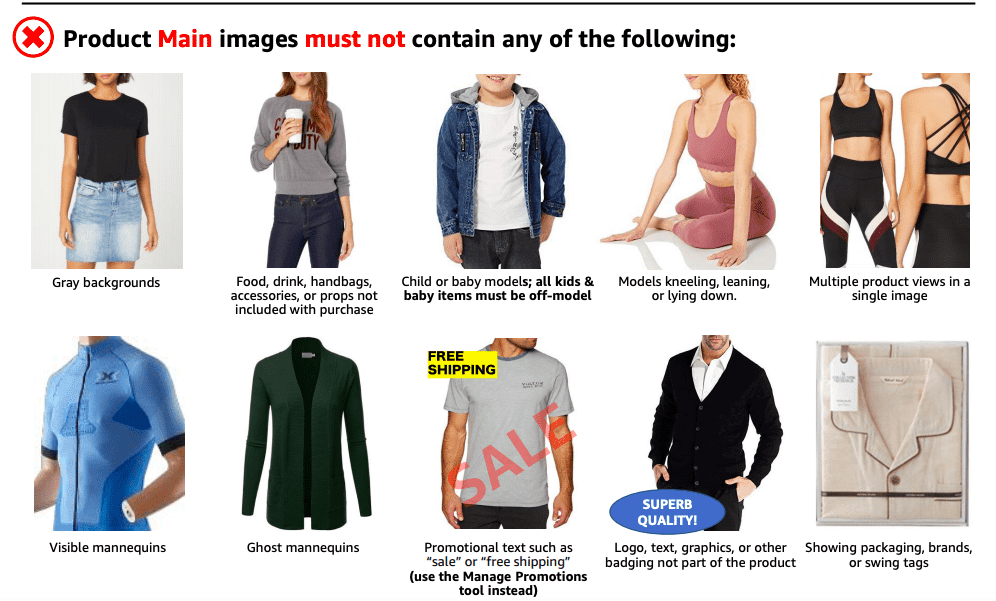
Check out the Amazon Fashion Imaging Guidelines, Clothing & Accesories, Spring 2021 to learn more!
Final Thoughts
Imagery is a key component to any Amazon listing. Apparel Images on Amazon are especially useful to help customers have a real idea of the item they’re purchasing.
Think about the context in which your images are viewed and think about the person looking at them. What can lure their attention? What should they know about your product? Remember Apparel Images will display on Amazon’s search results, besides your product page.
Having amazing, professional, high-resolution images is the best way to connect with your customers. Use this feature to your advantage!



